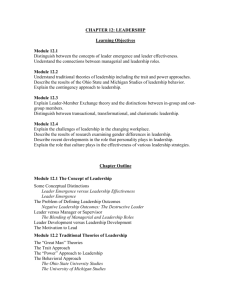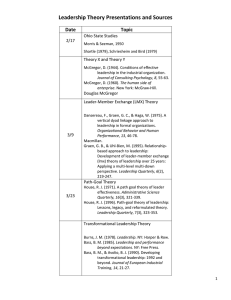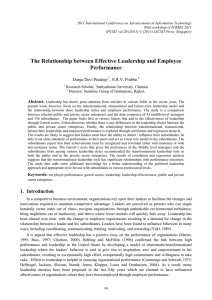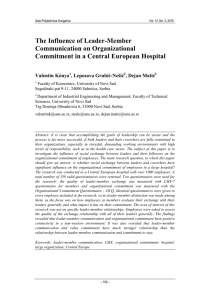Presentation Safety Intelligence_HF Conference November
advertisement
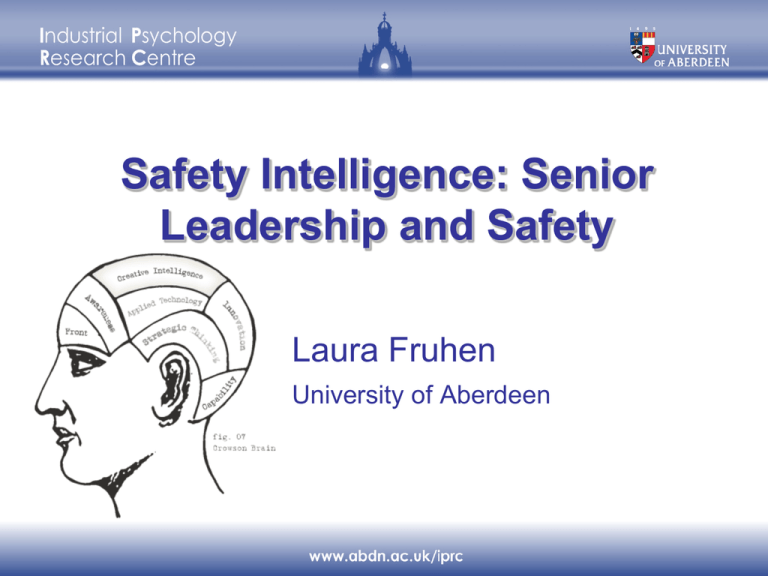
Safety Intelligence: Senior Leadership and Safety Laura Fruhen University of Aberdeen Outline • What is leadership? • Leadership and safety – Full range Leadership – Leader-Member-Exchange • Top Level Leadership and Safety – Leadership activities – Safety Intelligence What is leadership? Fleishman et al (1991) What is leadership? • Leadership = “[…] constituting a process of social influence that is enacted by designated individuals who hold formal leadership roles in organizations” (Kelloway & Barling, 2010; p. 261) • Leadership = “…the process of facilitating individual and collective efforts to accomplish shared objectives” (Yukl, 2002 ; p. 7) Process Definition of Leadership Trait Definition of Leadership Leader Leadership is determined by •Height •Intelligence •Extraversion •Masculinity •Dominance •Etc Interaction (e.g. Lord et al. 1986) Followers Theoretical approaches to leadership • The Trait Approach (1920-1930) – Leaders’ characteristics are different from nonleaders • The Behavioural Approach (1950s) – Behaviour leaders engage in • The Contingency Approach (1970s) – Takes the situation into account • New Leadership Approaches Leadership and Safety: What do we know? • Leadership style has an impact on safety (e.g. Kelloway, Mullen & Francis, 2006; Clarke & Ward, 2006) • Two examples – The full range leadership model (Bass, 1985) – Leader-member exchange (Dansereau, Cashman, & Graen, 1973) Leadership and Safety: The full range of Leadership Model (Bass, 1985) Transformational Leadership Transactional leadership Laissez Faire Leadership Leadership and Safety: The full range of Leadership Model (Bass, 1985) Transformational Leadership Transactional leadership Laissez Faire Leadership •Lowest level of leadership •Absence of leadership Leadership and Safety: The full range of Leadership Model (Bass, 1985) Transformational Leadership Transactional leadership Laissez Faire Leadership •Contingent reward •Management by exception Leadership and Safety: The full range of Leadership Model (Bass, 1985) Transformational Leadership Transactional leadership Laissez Faire Leadership •Idealised influence •Inspirational motivation •Intellectual stimulation •Individualised consideration The full range of Leadership Model and Safety + • Transformational Leadership Safety – (e.g. Zohar, 2002) • Laissez faire leadership - Safety – (e.g. Zohar, 2002) • The effects of transformational leadership style on performance are stronger in maximum contexts (Lim & Ployhart, 2004). Leadership and Safety: Leader-Member Exchange (LMX) (Danserau, Graen & Haga, 1975) • LMX focuses on the relation of the leader to each of their followers – Followers are divided into in-group and out-group members • Task of the leader: – drive the relationship from a tentative first stage to a deeper more meaningful one Leader Member Exchange Out Group In Group L L L L L L F2 F3 F1 F4 F5 F6 Leader-Member Exchange (LMX) and Safety + • LMX safety citizenship behaviour + • LMX safety citizenship role definitions – These relations are moderated by safety climate (Hofmann, Morgeson & Gerras, 2003) So far, • Leadership has been established as related to safety at lower organisational levels What about Senior level leadership? Are Senior managers positions different? Senior Managers and Safety • Senior Managers: – change and improve existing corporate culture (German Federal Bureau of Aircraft Accidents Investigation, 2004) – One of the most frequent employed safety climate factors (Guldenmund, 2000) – Commitment is one of the main drivers of employees safety performance (Michael, Evans, Jansen & Haight, 2005) • Only 5% of leadership literature focuses on senior management (Horn & Zaccaro, 2003) Can interpersonal theories also be applied to senior leadership? Interpersonal theories of leadership do not readily apply to executive forms of influence Horn & Zaccaro (2003) Strategic Leadership research should focus on the “substance in relation to leadership“ Day &Lord (1988) Executive leaders operate at a system wide and indirect level and in some cases never meet all their followers Zaccaro (2001) Senior leadership and safety programs Harper et al. (1996) Can you guess what patterns were described in the questionnaire? Personable communication Priority given to safe production • The quality of face-to-face • The attitude that the cost of contact between managers safety detracts from productivity and employees • being explicit that they are in • Perceived friendly the business of safe production communication • showing that production without • being interested in the safety is unacceptable employee as an individual • inquiring the employee’s health and general welfare or that of their family Another way of looking at senior managers and safety: Safety Intelligence • Skills and traits of senior executive managers in relation to safety • Abilities and Understanding regarding – Information – Safety risks to the organization – Decision making (Kirwan, 2008) What we don’t know so far! • What are the characteristics of the people at the top of an organisation who achieve high quality safety performance? The Skill Based Leadership Model adapted from Mumford et al. (2000) Investigation of Safety Intelligence Questionnaire study Aim: What constructs identified from the literature review are really relevant? Sample: • Subject matter experts (n=38) – senior managers – other managers that frequently interact with CEOs Measures • Questionnaire with two open questions How would you answer these two questions? – ‘What kind of person would you like an ideal CEO to be regarding his or her effect on safety?’ – ‘What behaviour would you like an ideal CEO to demonstrate regarding his or her effect on safety?’. How did we analyse the data? • Qualitative content analysis (Mayring, 2000) – Carried out by two independent coders – Interrater Agreements: • Behaviours: Kripp α = .664 • Characteristics: Kripp α = .776 Results of Questionnaire Analysis Social Competence Derived from Literature X Safety Knowledge X Problem Solving X Personality Motivation/ Safety Prioritisation X X Leadership Emerged from Dataset X X Results of Content Analysis (Percentage) 35 30 25 20 15 10 5 0 Behaviour Characteristics For further Exploration: Interview Study Sample: • CEOs and Board members (N =9) Measures • Exploratory Semi Structured Interview – Open questions & Probing questions – Scenarios Analysis • Qualitative content analysis – Carried out by two coders – Krippendorf’s α = 0.725 Results interview study How do you show your commitment to safety? – engagement in terms of ‘talking about safety and publishing material about safety’ – being ‘clear about one’s safety goals and safety itself’ – having safety on the top of the agenda – being proactive – be safe – give positive feedback and rewards The next step… Aim: How do the identified constructs affect safety outcomes? Sample: • CEOs and Board members (n = 1215 ANSPs) Measures • Semi Structured Interviews – Open questions – Scenarios • Questionnaires • Outcome Variables – Management commitment From your point of view • How would you transfer findings regarding senior managers and safety into the organisation? Thank you for your attention!


